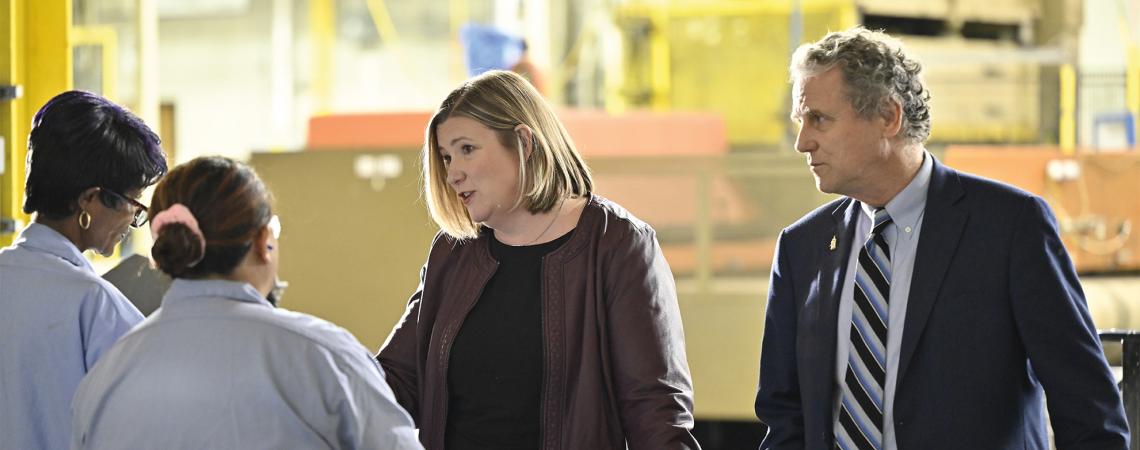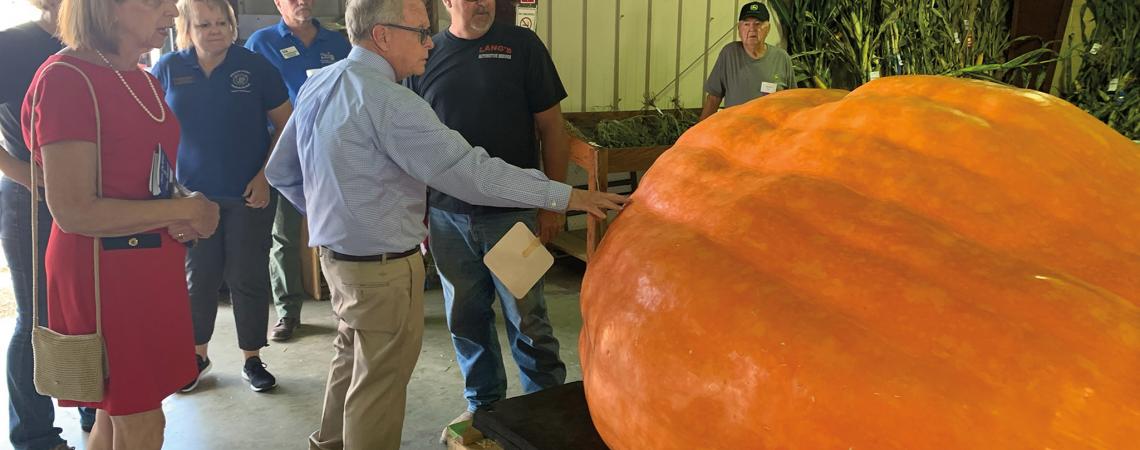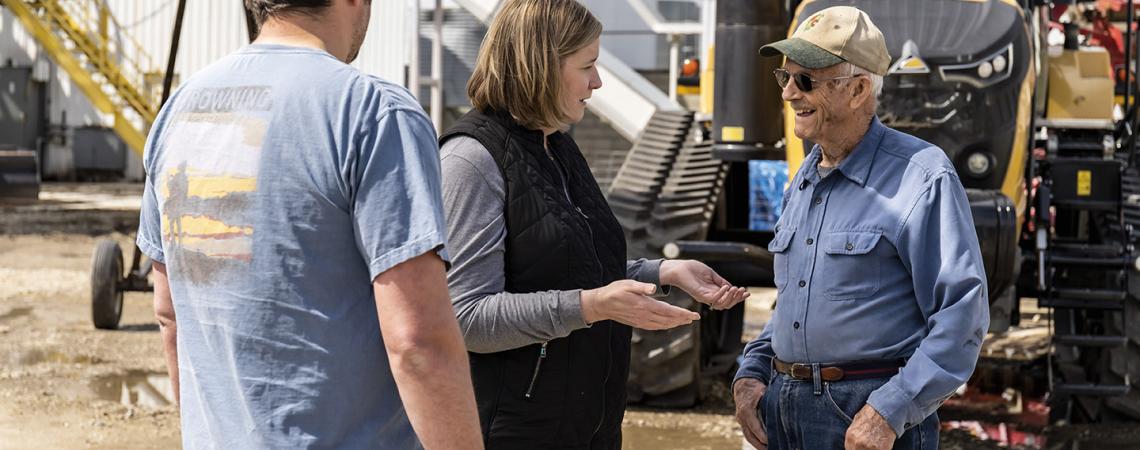Ohioans head to the voting booth Nov. 8 for one of the most consequential midterm elections in recent memory. Among the many significant decisions voters must make is who will lead the state’s executive branch as governor for the next four years.
Incumbent Mike DeWine, a former two-term U.S. senator, four-term congressman, and Ohio attorney general, is the Republican candidate, with Jon Husted, the current lieutenant governor and former Ohio secretary of state and speaker of the Ohio House, again serving as his running mate.

Challenger Nan Whaley is former mayor of Dayton, Ohio’s sixth-largest city, which she led from 2014 until 2022. Her running mate is Cheryl Stephens, a Cuyahoga County councilmember and former mayor of Cleveland Heights.

Knowing the importance of electric cooperative voters in the campaign, the candidates took some time recently to answer questions that are crucial to Ohio Cooperative Living readers.
Democratic nominee Nan Whaley, the former mayor of Dayton, says she is committed to Ohio’s working- and middle-class families.
If elected in November, what will be the issues of highest priority for your administration?
Mike DeWine: We must bring economic prosperity and hope to every part of Ohio. We must improve our economic development efforts in Ohio and focus on every part of the state. To succeed in a tech-focused economy, we are investing substantially in career education, job training, and workforce development. We are closing the digital divide so that all Ohioans have access to high-speed internet services, which will create opportunity for generations.
We must end the devastating opioid epidemic that is killing 15 Ohioans each day, flooding our foster care system with the children of addicts, and costing Ohio $8 billion each year. I have a 12-point plan of action that includes K-12 drug prevention education in all schools, more resources for law enforcement to fight the Mexican drug cartels, and increased treatment for individuals. This also means investing in mental health. The bottom line is this: Ohioans with untreated addiction and mental illness will remain underemployed and unemployed, and so much potential — for people, for families, for our state — will be lost if we do not take action.
We must continue to improve early childhood education to reach all Ohio children. We need more kids who are kindergarten-ready and must greatly increase the number of high-performing schools in Ohio. We need to ensure that every kid who graduates is job or college ready. To fail to do that is to fail our children.
Nan Whaley: I’m running for governor because I believe Ohio deserves better. For essentially 30 years, we’ve had one-party rule in our state and, during that time, we’ve watched as Ohio has fallen further and further behind. Our only path forward is a total overhaul — and that’s what I am proposing.
My message is pretty simple: I want your pay to go up, your bills to go down, and your government to work for you. That includes raising wages by investing in the jobs of the future, tackling inflation by temporarily suspending the gas tax and cracking down on price gouging, and finally, cleaning up corruption at the Statehouse.
This is how we make Ohio a place where one good job is enough, where every community is safe and healthy, and where your kids and grandkids have real opportunities.
What will you do to help improve the vitality of small towns and rural communities while improving economic opportunities for Ohioans in rural areas?
Nan Whaley: As a former mayor, I understand that shops, restaurants, and other small businesses are what make our communities vibrant. These face-to-face businesses have also suffered the most from the pandemic. I will convene local small business councils to maximize the use of federal and state resources to make sure that these businesses prosper in the post-pandemic economy. I will direct the Development Services Agency to redouble its efforts in making targeted commercial corridor investments in cities, towns, and villages across the state.
I know that broadband development is crucial to the economic viability of Ohio communities. I support initiatives that bring infrastructure and affordable broadband and high-speed internet access to unserved and underserved parts of the state. This also includes obtaining resources to rebuild, repair, and modernize transportation infrastructure to improve supply chain logistics. An important initiative of my administration will be to conduct an accurate statewide assessment of broadband connectivity to demonstrate the deep need in rural Ohio to help outline a plan for action. This assessment will help operationalize my commitment to providing universal broadband across Appalachian Ohio by 2028.
There should be ample opportunity for your kids and grandkids to build their lives anywhere in Ohio. Whether you live in a small town or a big city, in a suburb or on a farm, you deserve to have access to economic opportunity in Ohio. Ohio’s strength is in just how big and diverse our state is — we can’t afford to leave anyone behind. We need to invest in Ohio talent all across the state.
One good job should be enough. Every Ohioan deserves the dignity of work — a job that provides opportunity for your family and kids, regardless of your ZIP code. You should be free to collectively bargain; have a safe workplace; receive adequate health care; paid sick and family leave; and earn a wage that pays you fairly for the important value you provide.
We have what it takes to rebuild our economy. Our state is full of gritty entrepreneurs and resilient workers who have the skills and resources to make our state a place where everyone can thrive. But to do so, we need a governor and a government that is looking out for Ohio families, not special interests.
Mike DeWine: During my time as governor, we have created a record number of jobs, cut taxes, and won historic investments, all while balancing the budget. I want to continue to implement policies that give communities and workers the tools they need to succeed and then get out of their way.
To remove barriers to success, we are focusing efforts in areas of the state, such as Appalachia, where we are investing in downtown redevelopment. We are also closing the digital divide in Ohio, with the goal that everyone in Ohio will have access to high-speed internet, which will create opportunity for generations of Ohioans in our modern, tech-focused economy.
With an investment of $232 million in grants, Broadband Ohio estimates that around 230,000 residents will gain access to high-speed internet. Giving our rural and underserved areas access will be a boon for small towns and rural economies.
Lt. Gov. Husted and I are also working with the legislature to invest substantially in career education, job training, and workforce development to help give every Ohioan an opportunity to get a satisfying and well-paying job.
Further, my administration is committed to improving access to mental health and addiction services. We have created a landmark program to address the mental and physical health needs of children at school. Additionally, we have more than doubled medication-assisted drug treatment capacity across Ohio and have dramatically increased crisis stabilization services.
My goal is for Ohio to lead the world in behavioral health research and care. We can do this by investing significantly more in research and innovation, offering better crisis response services and treatment, increasing prevention efforts, and expanding residential and community-based services.













